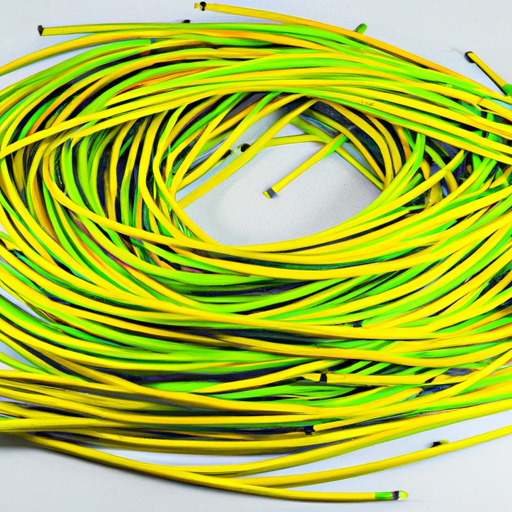
What is the Production Process of Mainstream Yellow-Green Heat Shrinkable Tubing?
Heat shrinkable tubing is an essential component in various industries, including electrical, automotive, and telecommunications. Among the various colors available, yellow-green heat shrinkable tubing is particularly significant due to its use in grounding and safety applications. This blog post will delve into the production process of mainstream yellow-green heat shrinkable tubing, exploring the materials, manufacturing techniques, and quality control measures involved.
1. Understanding Heat Shrinkable Tubing
Before diving into the production process, it’s crucial to understand what heat shrinkable tubing is. Heat shrinkable tubing is a type of plastic tubing that shrinks in diameter when heated. It is typically made from materials like polyolefin, PVC, or fluoropolymers. The primary purpose of this tubing is to provide insulation, protection, and strain relief for electrical connections and components.
1.1 Importance of Yellow-Green Color
The yellow-green color of heat shrinkable tubing is often used to indicate grounding or protective earth connections in electrical systems. This color coding is vital for safety, ensuring that technicians and engineers can quickly identify grounding wires and components, reducing the risk of electrical shock or equipment damage.
2. Raw Materials
The production of yellow-green heat shrinkable tubing begins with the selection of raw materials. The most common materials used are:
2.1 Polyolefin
Polyolefin is the most widely used material for heat shrinkable tubing due to its excellent electrical insulation properties, chemical resistance, and flexibility. It is also lightweight and can withstand a range of temperatures.
2.2 Colorants
To achieve the yellow-green color, specific colorants are added to the polyolefin during the manufacturing process. These colorants must be durable and resistant to fading, ensuring that the tubing maintains its visibility and effectiveness over time.
2.3 Additives
Various additives may be included to enhance the properties of the tubing. These can include UV stabilizers, flame retardants, and anti-static agents, depending on the intended application of the tubing.
3. Manufacturing Process
The production of yellow-green heat shrinkable tubing involves several key steps:
3.1 Extrusion
The first step in the manufacturing process is extrusion. In this process, the raw polyolefin material is fed into an extruder, where it is heated and melted. The molten material is then forced through a die to create a continuous tube. The diameter of the tube is carefully controlled to ensure it meets the required specifications.
3.2 Cooling
Once the tubing is extruded, it is cooled rapidly to solidify the material. This cooling process is crucial, as it helps to set the shape of the tubing and prepares it for the next stage of production.
3.3 Orientation
After cooling, the tubing undergoes a process called orientation. This involves stretching the tubing in both the longitudinal and circumferential directions. The orientation process is essential for creating the heat shrinkable properties of the tubing. When the tubing is heated later, it will shrink back to its original diameter, providing a tight fit around the components it covers.
3.4 Coloring
To achieve the yellow-green color, the tubing is subjected to a coloring process. This can be done during the extrusion phase by adding colorants to the raw material or through a secondary process where the tubing is coated with a colored layer. The chosen method depends on the desired durability and appearance of the final product.
3.5 Cutting
Once the tubing has been colored, it is cut into specific lengths based on customer requirements. This cutting process can be automated for efficiency, ensuring that each piece is uniform and meets the specified dimensions.
4. Quality Control
Quality control is a critical aspect of the production process for yellow-green heat shrinkable tubing. Manufacturers implement several measures to ensure that the final product meets industry standards and customer expectations.
4.1 Material Testing
Before production begins, raw materials are tested for quality and consistency. This includes checking the properties of the polyolefin, colorants, and additives to ensure they meet the required specifications.
4.2 Dimensional Inspection
Throughout the manufacturing process, the dimensions of the tubing are regularly inspected. This includes measuring the diameter, wall thickness, and length to ensure they conform to the specified tolerances.
4.3 Shrinkage Testing
One of the most critical tests for heat shrinkable tubing is the shrinkage test. Samples of the tubing are heated to the specified temperature, and the amount of shrinkage is measured. This test ensures that the tubing will perform as expected when applied in real-world conditions.
4.4 Electrical Testing
For heat shrinkable tubing used in electrical applications, electrical testing is essential. This includes checking the insulation resistance and dielectric strength to ensure that the tubing provides adequate protection for electrical components.
5. Applications of Yellow-Green Heat Shrinkable Tubing
Yellow-green heat shrinkable tubing is used in various applications, primarily in electrical and electronic systems. Some common uses include:
5.1 Grounding Connections
As mentioned earlier, the yellow-green color is often used for grounding connections in electrical systems. This helps to ensure that grounding wires are easily identifiable, promoting safety and compliance with electrical codes.
5.2 Cable Insulation
Heat shrinkable tubing is commonly used to insulate and protect cables from environmental factors, such as moisture, chemicals, and abrasion. The yellow-green tubing provides an additional layer of safety for grounding cables.
5.3 Strain Relief
In applications where cables are subject to movement or stress, heat shrinkable tubing can provide strain relief. By shrinking tightly around the cable, it helps to prevent damage to the connections and prolongs the life of the cable.
6. Conclusion
The production process of mainstream yellow-green heat shrinkable tubing involves a series of carefully controlled steps, from the selection of raw materials to the final quality control measures. Understanding this process is essential for manufacturers and users alike, as it highlights the importance of quality and safety in electrical applications. As industries continue to evolve, the demand for reliable and effective heat shrinkable tubing will only grow, making it a vital component in modern technology.




